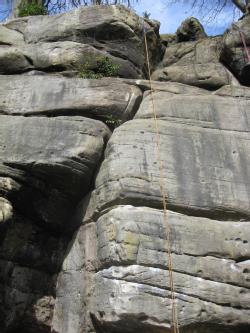About
Oliver began postgraduate study in the Glass and Glass Ceramics Group in October 2009, after graduating with first class honours from the physics department's four year MPhys program. His work predominantly involves the elucidation and modelling of the atomic structure in oxide glasses through the use of a wide range of experimental techniques. The focus has been on the handling and interpretation of elastic neutron and x-ray scattering data, including atomistic modelling, as well as solid-state nuclear magnetic resonance.
Outside of work Oliver's interests include rock climbing, camping, walking, cycling and reading.
Research Interests
- The atomic arrangement in bulk oxide glasses, and its relation to observed physio-chemical properties.
There are a huge array of experimental probes available for the study of atomic structure in condensed matter. The single greatest challenge in the study of glass structure is the fundamental lack of long range order. Whilst the existence of periodicity of atomic sites is exploited to huge success in the study of the crystalline state, where well defined atomic planes give rise to Bragg diffraction, the vitreous state is structurally akin to a "frozen" liquid, in which the concept of a unit cell is redundant. As such, it is desirable to use a number of complementary techniques when tackling the problem of structure in a disordered material.
The primary techniques to be used in the present study are neutron and x-ray diffraction, complemented by solid state Nuclear Magnetic Resonance (NMR). The diffraction techniques are complementary to each other, and are used to extract radial distribution functions which show, in an average way, the distances between all atomic pairs in the glass. Such functions require careful interpretation, in which the use of isotopic substitution and anomalous x-ray scattering can be of great use (despite practical difficulties). The Reverse Monte-Carlo and Empirical Potential Structure Refinement techniqes are both means of fitting an atomistic model to diffraction data, which can be used, with care, to extract information not directly available from the diffraction data itself. It is vital to test such models using other techniques, and this is one area in which NMR is of great use. As a nucleus specific local structural probe, NMR is ideally suited to the study of disordered materials.
Other techniques to be used include measurements of bulk density, thermal and optical properties. Of course, a huge number of other experimental probes exist, and it is always important to have a clear idea of the question one seeks to answer, and so choose the most appropriate tool. It is likely that a number of alternative methods will be employed, such as Raman and IR spectroscopies, EXAFS/XANES and electron diffraction.
- Lone Pair Cations in Glass
As part of the group's larger interest in the structure of oxide glasses containing lone pair cations such as Sn2+, Sb3+, Te4+, Tl+, Pb2+, Bi3+ and Po4+, lead containing silicates and germanates are under study over broad compositional ranges. When sterically active, lone pair cations are found to impart a greater glass forming ability on an oxide melt, in comparison to more ionic components such as the cations of the oxides of the alkali and alkaline earth elements.
- Thermal History of Glasses, and Devitrification
The thermal history of a glass can have great implications for its structure and properties. This is particularly apparent in the devitrification process, where parameters such as quench rate, glass-forming melt temperature and annealing time can be adjusted to yeild different crystalline polymorphs in a stoichiometric glass. Barium diborate glass is at present being used as a case study in this area. The influence of cooling rate on glass structure has practical significance as well as basic research interest. Rapid quenching by, for example, the twin roller quenching technique, has been used to produce a series of lead silicate glasses, both to extend the traditional glass forming region, and in order to seek subtle structural differences, as compared to glasses formed by more gentle cooling.

Sandstone at Bowles rocks, near Tunbridge Wells
